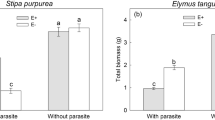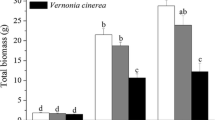Abstract
Endophytic plant symbionts can have powerful effects on the way their hosts interact with pathogens, competitors, and consumers. The presence of endophytes in plants can alter food webs, community composition and ecosystem processes, suggesting that endophyte-plant symbioses may represent unique forms of extended phenotypes. We tested the impact of the fungal endophyte Alternaria alternata (phylotype CID 120) on the allelopathic effect of the invasive forb Centaurea stoebe when in competition with the North American native bunchgrass Koeleria macrantha in a greenhouse competition experiment. The allelopathic effect of C. stoebe on K. macrantha when infected with the fungal endophyte was more than twice that of endophyte-free C. stoebe. However, this allelopathic effect was a small part of the very large competitive effect of C. stoebe on K. macrantha in all treatments, likely because of the priority effects in our experimental design. To our knowledge, these results are the first experimental evidence for a symbiotic relationship between plants and fungal endophytes affecting allelopathic interactions between competing plants, and thus provide insight into the mechanisms by which fungal endophytes may increase the competitive ability of their hosts.


Similar content being viewed by others
References
Aschehoug ET, Metlen K, Callaway RM, Newcombe G (2012) Fungal endophytes directly increase the competitive effects of an invasive forb. Ecology 93:3–8
Barto EK, Hilker M, Müller F, Mohney BK, Weidenhamer JD, Rillig MC (2011) The fungal fast lane: common mycorrhizal networks extend bioactive zones of allelochemicals in soils. PLoS One 6:e27195
Baynes M, Newcombe G, Dixon L, Castlebury L, O’Donnell K (2012) A novel plant–fungal mutualism associated with fire. Fungal Biol 116:133–144
Besaw L, Thelen G, Sutherland S, Metlen K, Callaway RM (2011) Disturbance, resource pulses, and invasion: short-term shifts in competitive effects, not growth responses, favor exotic annuals. J Appl Ecol 48:998–1006
Bronstein JL (2001) The costs of mutualism. Am Zool 41:825–839
Bronstein JL, Dieckmann U, Ferrière R (2004) Coevolutionary dynamics and the conservation of mutualisms. In: Ferrière R, Dieckmann U,Couvet D (eds) Evolutionary conservation biology. Cambridge University Press, Cambridge, pp 305–326
Bush LP, Wilkinson HH, Schardl CL (1997) Bio-protective alkaloids of grass-fungal endophyte symbioses. Plant Physiol 114:1–7
Callaway RM, Aschehoug ET (2000) Invasive plants versus their new and old neighbors: a mechanism for exotic invasion. Science 290:521–523
Callaway RM, Brooker R, Choler P, Kikvidze Z, Lortie CJ, Michalet R, Paolini L, Pugnaire FI, Newingham B, Aschehoug ET (2002) Positive interactions among alpine plants increase with stress. Nature 417:844–848
Callaway RM, Thelen GC, Barth S, Ramsey PW, Gannon JE (2004) Soil fungi alter interactions between the invader Centaurea maculosa and North American natives. Ecology 85:1062–1071
Callaway RM, Bedmar EJ, Reinhart KO, Silvan CG, Klironomos J (2011) Effects of soil biota from different ranges on Robinia invasion: acquiring mutualists and escaping pathogens. Ecology 92:1027–1035
Chen S, Xiao S, Callaway RM (2012) Light intensity alters the allelopathic effects of an exotic invader. Plant Ecol Divers 5:521–526
Cheplick GP, Faeth S (2009) Ecology and evolution of the grass-endophyte symbiosis. Oxford University Press, New York
Clay K (1988) Fungal endophytes of grasses: a defensive mutualism between plants and fungi. Ecology 69:10–16
Clay K, Holah J, Rudgers J (2005) Herbivores cause a rapid increase in hereditary symbiosis and alter plant community composition. Proc Natl Acad Sci USA 102:12465–12470
Dawkins R (1982) The extended phenotype. Oxford University Press, New York
Elmi A, West C (1995) Endophyte infection effects on stomatal conductance, osmotic adjustment and drought recovery of tall fescue. New Phytol 131:61–67
Faeth S (2002) Are endophytic fungi defensive plant mutualists? Oikos 98:25–36
Faeth SH, Helander ML, Saikkonen KT (2004) Asexual Neotyphodium endophytes in a native grass reduce competitive abilities. Ecol Lett 7:304–313
Gurevitch J (1986) Competition and the local distribution of the grass Stipa neomexicana. Ecology :46–57
Inderjit, Pollock JL, Callaway R, Holben W (2008) Phytotoxic effects of (±)-catechin in vitro, in soil, and in the field. PLoS One 3:2536
Inderjit, Wardle DA, Karban R, Callaway RM (2011) The ecosystem and evolutionary contexts of allelopathy. Trends Ecol Evol 26:655–662
Jensen CG, Ehlers BK (2010) Genetic variation for sensitivity to a thyme monoterpene in associated plant species. Oecologia 162:1017–1025
Karban R (2007) Experimental clipping of sagebrush inhibits seed germination of neighbours. Ecol Lett 10:791–797
Kaur H, Kaur R, Kaur S, Baldwin IT, Inderjit (2009) Taking ecological function seriously: soil microbial communities can obviate allelopathic effects of released metabolites. PLoS One 4:e4700
Koh S, Hik D (2007) Herbivory mediates grass-endophyte relationships. Ecology 88:2752–2757
Lankau RA, Strauss SY (2007) Mutual feedbacks maintain both genetic and species diversity in a plant community. Science 317:1561–1563
Mahall BE, Callaway RM (1992) Root communication mechanisms and intracommunity distributions of two Mojave Desert shrubs. Ecology 73:2145–2151
Marks S, Clay K, Cheplick G (1991) Effects of fungal endophytes on interspecific and intraspecific competition in the grasses Festuca arundinacea and Lolium perenne. J Appl Ecol 28:194–204
Marler MJ, Zabinski CA, Callaway RM (1999) Mychorrhizae indirectly enhance competitive effects of an invasive forb on a native bunchgrass. Ecology 80:1180–1186
Murrell C, Gerber E, Krebs C, Parepa M, Schaffner U, Bossdorf O (2011) Invasive knotweed affects native plants through allelopathy. Am J Bot 98:38–43
Musetti R, Polizzotto R, Vecchione A, Borselli S, Zulini L, D’Ambrosio M, Toppi L, Pertot I (2007) Antifungal activity of diketopiperazines extracted from Alternaria alternata against Plasmopara viticola: an ultrastructural study. Micron 38:643–650
Newcombe G, Shipunov A, Eigenbrode S, Raghavendra A, Ding H, Anderson C, Menjivar R, Crawford M, Schwarzländer M (2009) Endophytes influence protection and growth of an invasive plant. Commun Integr Biol 2:29
Pollock J, Callaway R, Thelen G, Holben W (2009) Catechin–metal interactions as a mechanism for conditional allelopathy by the invasive plant Centaurea maculosa. J Ecol 97:1234–1242
Raghavendra AKH, Newcombe G, Shipunov A, Baynes M, Tank D (2013) Exclusionary interactions among diverse fungi infecting developing seeds of Centaurea stoebe. FEMS Microbiol Ecol 84:143-153
Renne IJ, Rios BG, Fehmi JS, Tracy BF (2004) Low allelopathic potential of an invasive forage grass on native grassland plants: a cause for encouragement? Basic Appl Ecol 5:261–269
Ridenour WM, Callaway RM (2001) The relative importance of allelopathy in interference: the effects of an invasive weed on a native bunchgrass. Oecologia 126:444–450
Rudgers JA, Orr S (2009) Non-native grass alters growth of native tree species via leaf and soil microbes. J Ecol 97:247–255
Rudgers JA, Fischer S, Clay K (2010) Managing plant symbiosis: fungal endophyte genotype alters plant community composition. J Appl Ecol 47:468–477
Saikkonen K, Lehtonen P, Helander M, Koricheva J, Faeth SH (2006) Model systems in ecology: dissecting the endophyte-grass literature. Trends Plant Sci 11:428–433
Shipunov A, Newcombe G, Raghavendra AKH, Anderson CL (2008) Hidden diversity of endophytic fungi in an invasive plant. Am J Bot 95:1096–1108
Sutherland BL, Hume DE, Tapper BA (1999) Allelopathic effects of endophyte infected perennial ryegrass extracts on white clover seedlings. N Z J Agric Res 42:19–26
Tharayil N, Triebwasser D (2010) Elucidation of a diurnal pattern of catechin exudation by Centaurea stoebe. J Chem Ecol 36:200–204
Tharayil N, Bhowmik P, Alpert P, Walker E, Amarasiriwardena D, Xing B (2009) Dual purpose secondary compounds: phytotoxin of Centaurea diffusa also facilitates nutrient uptake. New Phytol 181:424–434
Thorpe AS, Callaway RM (2011) Biogeographic differences in the effects of Centaurea stoebe on the soil nitrogen cycle: novel weapons and soil microbes. Biol Invasions 13:1435–1445
Thorpe AS, Thelen GC, Diaconu A, Callaway RM (2009) Root exudate is allelopathic in invaded community but not in native community: field evidence for the novel weapons hypothesis. J Ecol 97:641–645
Vázquez-de-Aldana BR, Romo M, Petisco C, García-Criado B (2011) Infection with the fungal endophyte Epichloë festucae may alter the allelopathic potential of red fescue. Ann Appl Biol 159:281–290
Vázquez-de-Aldana BR, Zabalgogeazcoa I, García-Ciudad A, García-Criado B (2013) An Epichloë endophyte affects the competitive ability of Festuca rubra against other grassland species. Plant Soil 362:201–213
Wang RL, Zeng RS, Peng SL, Chen BM, Liang XT, Xin XW (2011) Elevated temperature may accelerate invasive expansion of the liana plant Ipomoea cairica. Weed Res 51:574–580
Whitham TG, Young WP, Martinsen GD, Gehring CA, Schweitzer JA, Shuster SM, Wimp GM, Fischer DG, Bailey JK, Lindroth RL (2003) Community and ecosystem genetics: a consequence of the extended phenotype. Ecology 84:559–573
Xiao S, Callaway RM, Newcombe G, Aschehoug ET (2012) Models of experimental competitive intensities predict home and away differences in invasive impact and the effects of an endophyte mutualist. Am Nat 180:707–718
Acknowledgments
Shuyan Chen thanks the National Natural Science Foundation of China (grant numbers 31000178, 31000203, 31230014) for financial support. The authors declare no conflicts of interest. Ragan M. Callaway thanks the NSF EPSCoR Track-1 EPS-1101342 (INSTEP 3) for support.
Author information
Authors and Affiliations
Corresponding author
Additional information
Communicated by Catherine Gehring.
Rights and permissions
About this article
Cite this article
Aschehoug, E.T., Callaway, R.M., Newcombe, G. et al. Fungal endophyte increases the allelopathic effects of an invasive forb. Oecologia 175, 285–291 (2014). https://doi.org/10.1007/s00442-014-2891-0
Received:
Accepted:
Published:
Issue Date:
DOI: https://doi.org/10.1007/s00442-014-2891-0




